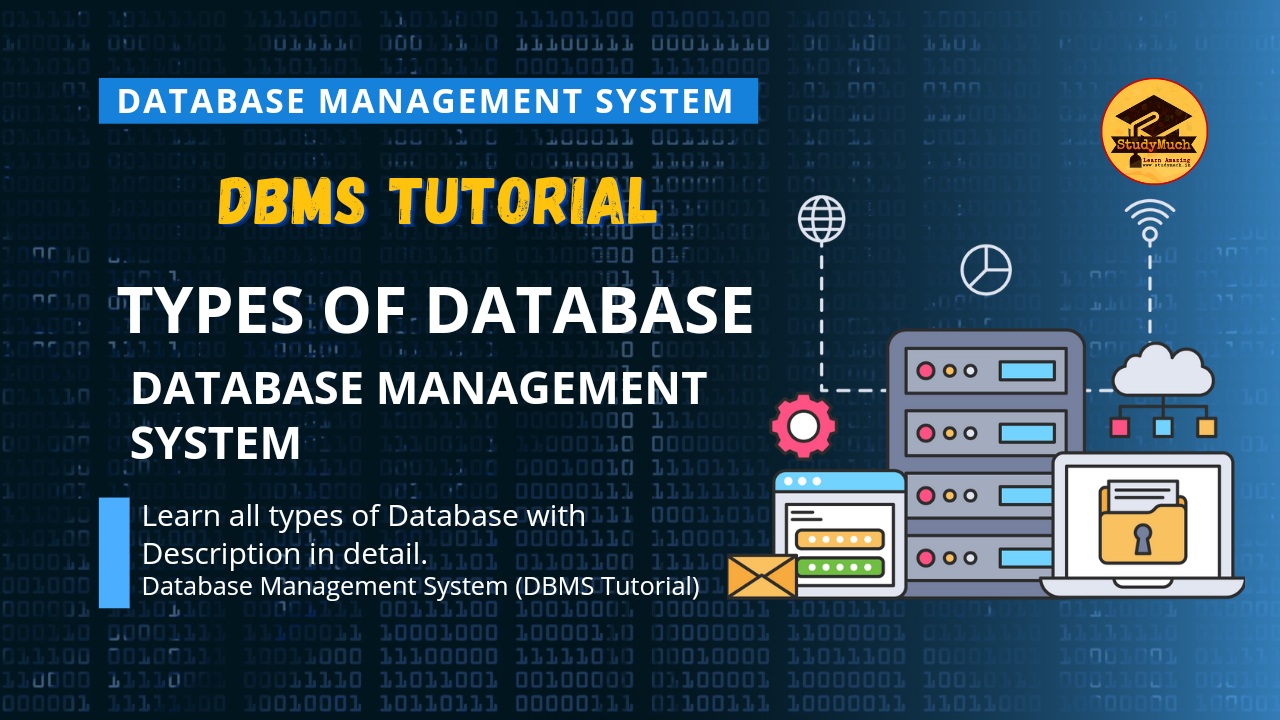Types of Database

Types of Database;
In this tutorial you will learn the “Type of Database” with full details and description, there are many types of databases, in Database management system, and here we provided you some important types of Databases in with description and full details.
There are several types of database, each with its own unique features and characteristics. Here are some common types of databases:
1. Relational Database:
A relational database is a type of database that uses a tabular structure to organize data into rows and columns, with relationships established between different tables using keys. The data is stored in tables with predefined schemas, and it follows a fixed structure. Relational databases use Structured Query Language (SQL) for querying and managing data. Examples of relational databases include MySQL, Oracle Database, and Microsoft SQL Server.
2. Personal Database;
A personal database is a type of database that is specifically designed for individual use, typically by an individual person or a small group of people, to store and manage personal data, information, or content. It is often used to keep track of personal contacts, schedules, notes, tasks, and other types of personal information.
Personal databases can come in various forms, including desktop applications, mobile apps, web-based applications, or cloud-based services, and they may be accessed through computers, smartphones, or other personal devices.
Personal databases are typically used for personal organization, information management, and productivity purposes. They allow individuals to store and organize their personal data in a structured manner, making it easy to retrieve and manage information efficiently. Personal databases can include various types of data, such as contact information, calendar events, to-do lists, notes, photos, documents, and other personal content.
3. NoSQL Database:
NoSQL (Not Only SQL) databases are a type of database that does not follow the traditional tabular structure of relational databases. NoSQL databases are used for handling unstructured, semi-structured, and structured data. They are highly scalable and designed for handling large volumes of data. Examples of NoSQL databases include MongoDB, Cassandra, and Amazon DynamoDB.
4. Object-oriented Database:
An object-oriented database is a type of database that stores data in the form of objects, which are instances of classes in object-oriented programming. It is used to store complex data structures such as multimedia data, spatial data, and scientific data. Object-oriented databases provide support for object-oriented concepts such as encapsulation, inheritance, and polymorphism. Examples of object-oriented databases include ObjectDB and Versant.

5. Hierarchical Database:
A hierarchical database is a type of database that organizes data in a tree-like structure, with parent-child relationships between data elements. It is suitable for storing data with one-to-many relationships, where each parent record can have multiple child records, but each child record can only have one parent. Hierarchical databases were commonly used in early mainframe systems and are still used in some legacy systems today.
6. Network Database:
A network database is a type of database that organizes data using a network model, where data elements are connected in a network-like structure with multiple relationships. It is similar to hierarchical databases, but it allows for more complex relationships between data elements. Network databases were also popular in early mainframe systems and are still used in some legacy systems today.
7. Time-series Database:
A time-series database is a type of database that specializes in handling data that changes over time, such as sensor data, financial data, or log data. It is optimized for storing and retrieving data in chronological order, allowing for efficient analysis and querying of time-stamped data. Examples of time-series databases include InfluxDB, OpenTSDB, and TimescaleDB.
8. Spatial Database:
A spatial database is a type of database that is designed for storing and querying spatial data, such as maps, geographic information systems (GIS), and location-based data. Spatial databases use specialized data structures and algorithms to efficiently store and retrieve data based on spatial attributes, such as points, lines, and polygons. Examples of spatial databases include PostGIS, Oracle Spatial, and GeoServer.
9. Columnar Database:
A columnar database is a type of database that stores data in columns rather than rows, which allows for efficient compression and storage of data. Columnar databases are optimized for read-heavy workloads and are often used in data warehousing and analytics applications, where fast query performance is critical. Examples of columnar databases include Google Bigtable, Amazon Redshift, and Apache Cassandra.
10. In-memory Database:
An in-memory database is a type of database that stores data in the main memory (RAM) of a computer, rather than on disk. This allows for extremely fast data retrieval and processing speeds, making in-memory databases suitable for applications that require real-time data processing or low-latency access to data. Examples of in-memory databases include SAP HANA, Redis, and VoltDB.
11. Operational Database;
An operational database is a type of database that is designed for day-to-day, transactional operations within an organization. It is used to support the operational processes and activities of an organization, such as capturing, storing, retrieving, and updating data related to business transactions, customer interactions, inventory management, financial transactions, and other operational activities.
Operational databases are typically optimized for high-speed data input and retrieval, as they need to handle a large volume of transactions in real-time. They are also designed to ensure data integrity, consistency, and accuracy, as they are critical for the smooth functioning of business operations.

12. Enterprise Database;
An enterprise database is a type of database that is used by large organizations, such as corporations, government agencies, and other complex institutions, to store and manage vast amounts of data that is critical for their daily operations, decision-making, and strategic planning. Enterprise databases are designed to handle large volumes of data from various sources, support multiple users and concurrent access, and provide robust features for data integrity, security, and performance.
Enterprise databases are typically used to store a wide range of data, including transactional data, customer data, product data, financial data, human resources data, supply chain data, and other types of organizational data. They may utilize different database models, such as relational, NoSQL, or hybrid models, depending on the requirements and nature of the data being stored.
13. Cloud Database
A cloud database is a type of database that is hosted and managed on cloud computing platforms. Cloud computing allows for the delivery of computing resources, including databases, over the internet as a service, eliminating the need for organizations to build and maintain their own physical infrastructure.
Cloud databases are designed to be highly scalable, flexible, and cost-effective, making them ideal for organizations of all sizes, from small businesses to large enterprises. They offer several benefits, including on-demand resource provisioning, pay-as-you-go pricing, automated backups, and global accessibility, which allow organizations to scale their databases up or down based on their needs and only pay for the resources they use.
Cloud databases can be categorized into different types, such as relational databases, NoSQL databases, and specialized databases like time-series databases or graph databases, and they are typically accessed and managed using web-based interfaces or APIs provided by the cloud service provider.
So, in this tutorial you have learned “Types of Database”, DBMS, if you have any doubts and problems regarding this tutorial, you can ask me in the comment section.
Related Topics;



1 Comment
best cheap seo services · August 10, 2023 at 10:28 am
Wow, great blog.Much thanks again.